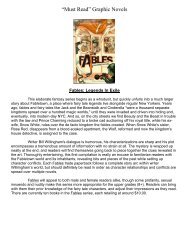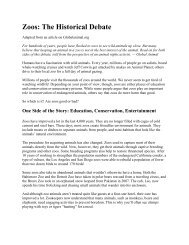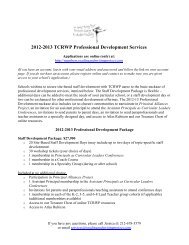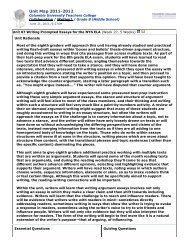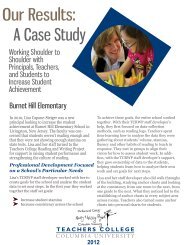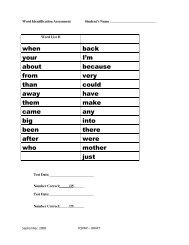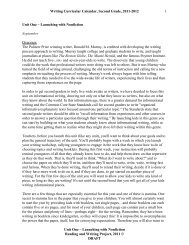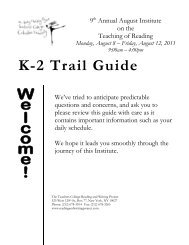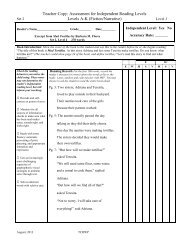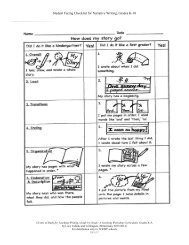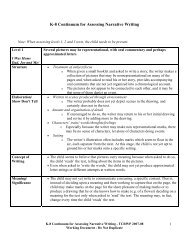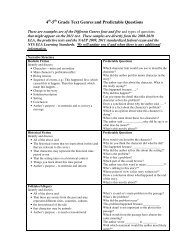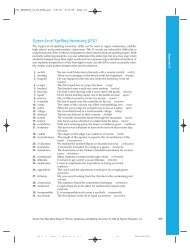Continuum for Assessing Opinion/Argument Writing - The Reading ...
Continuum for Assessing Opinion/Argument Writing - The Reading ...
Continuum for Assessing Opinion/Argument Writing - The Reading ...
You also want an ePaper? Increase the reach of your titles
YUMPU automatically turns print PDFs into web optimized ePapers that Google loves.
Dear Teachers,<br />
This is the most recent version of the <strong>Continuum</strong> <strong>for</strong> <strong>Assessing</strong> <strong>Opinion</strong> <strong>Writing</strong>. It is still<br />
in the development process, but we wanted to get it into your hands as soon as possible to<br />
help you to assess your writers as you prepare to begin the October essay units. We are<br />
giving you levels 1-8, with 8 corresponding to the end of fifth grade, according to student<br />
work samples and Common Core alignment. We will distribute levels 9-12 soon.<br />
Accompanying student work is <strong>for</strong>thcoming as well. We welcome and would greatly<br />
appreciate any feedback you have <strong>for</strong> us on the readability and effectiveness of this<br />
assessment tool.<br />
Thank you,<br />
Anna Gratz Cockerille and Ali Marron<br />
anna@readingandwritingproject.com<br />
ali@readingandwritingproject.com<br />
Dear Teachers,<br />
This tool has been developed to help you understand, support and track your students’<br />
progress in what the Common Core refers to as “opinion writing.” You and your students<br />
may use more precise terms, referring to this general kind of writing as persuasive letter<br />
writing, as essay writing, as editorial writing, as review writing, and so <strong>for</strong>th. It is helpful<br />
to understand that all of those somewhat different kinds of writing are similar, and to<br />
realize that when you teach well, your students will progress along a fairly predictable<br />
pathway of development.<br />
Prompting Students to Produce On-Demand <strong>Opinion</strong> <strong>Writing</strong><br />
<strong>The</strong> continuum can be used to assess work that is the result of rough drafts, revision,<br />
conferences, and adult coaching–and should be. But it is especially designed as a way to<br />
assess on-demand writing. In order <strong>for</strong> students’ work to be compared, one with another,<br />
it is important that the conditions in which the work is done be as consistent as possible<br />
across classrooms. <strong>The</strong>re<strong>for</strong>e, we have provided you with a prompt that we hope you use<br />
to ask students to create a piece of on-demand writing. Please use only this prompt,<br />
exactly as it is written, and resist the urge to preface it with some fast pointers, or<br />
otherwise to provide further instruction, coaching, and explanation!<br />
You may read the prompt with raised eyebrow, thinking, ‘Really I should say this to my<br />
six year olds’ We did initially write very different versions of the prompt <strong>for</strong> K-2 kids<br />
than that which we used <strong>for</strong> 3-8 writers. But there were lots of resulting problems because<br />
in fact, there will be sixth graders who produce texts that are levels 4 (a level that is<br />
intended as at-standard <strong>for</strong> first graders). And there will be first graders who produce<br />
writing at level 6 (that is, at a level intended <strong>for</strong> third graders.) In order <strong>for</strong> this to be a<br />
true continuum of writing, one in which the levels reflect abilities and not grade levels,<br />
K-8 <strong>Continuum</strong> <strong>for</strong> <strong>Assessing</strong> <strong>Opinion</strong> <strong>Writing</strong> - TCRWP 2011<br />
Working Document - Do Not Duplicate, Do Not Distribute<br />
DRAFT<br />
1
we came to believe it is necessary that the work produced by different grade levels could<br />
fall anywhere on the spectrum, and that all the pieces at a level--say, Level 5--be<br />
comparable because they result from essentially the same prompt. Hence we have written<br />
one prompt that works, in a way, <strong>for</strong> Grades K-8. Granted, we know that most<br />
kindergarteners are not taking advantage of the planning time to collect facts and quotes<br />
to help make their argument, but the fact that they were invited to do this and did not do it<br />
is significant--especially when it is fourth graders, not kindergarteners, who may not be<br />
doing this.<br />
<strong>The</strong> prompt is more detailed, more explanatory, than the assignments children will<br />
encounter on high stakes tests. This was a decision we made because we won’t learn<br />
much if students simply read the question, ask, ‘huh’ and sit there—as a kindergartner<br />
would be apt to do with a prompt that might have been designed <strong>for</strong> a middle-school<br />
high-stakes test. Still, the prompt does require children to know some writing lingo. If<br />
they do not understand the terms that are in this prompt, it is true that this means that the<br />
writer will not per<strong>for</strong>m particularly well. Please don’t solve this by talking on and on<br />
about the assignment. Just give the prompt as it is written, and if the kids do not know<br />
how to proceed, that should be revealing. After you teach opinion writing, they’ll have<br />
access to academic language related to this kind of writing and will demonstrate their<br />
knowledge and skills on the ‘post’ assessment.<br />
<strong>The</strong> Prompt:<br />
To be given the day be<strong>for</strong>e:<br />
Think of a topic or issue that you know a lot about or that you have strong feelings about.<br />
Tomorrow, you will have an hour to write an opinion or argument text in which you will<br />
write your opinion or claim and tell reasons why you feel that way. Use everything you<br />
know about essay writing, letter writing, speeches, and reviews. If you want to find and<br />
use in<strong>for</strong>mation from a book or another outside source, you may bring that with you<br />
tomorrow. Please keep in mind that you’ll have an hour to complete this.<br />
To be given on the day of the assessment:<br />
Writers, in fifteen minutes you will have a chance to do some opinion writing. You’ll<br />
want to think of an idea or an opinion that you have--one you have strong feelings about--<br />
and to write to convince your readers of your opinion. You can’t start the actual writing<br />
yet, but you do have 15 minutes to think about that writing, and get ready to do it. If you<br />
want to make notes, to take in<strong>for</strong>mation from books or from people in the room or from<br />
anything else, you can do so--you just want to be sure that in 15 minutes, you will be able<br />
to write about your opinion in ways that convince others.<br />
(<strong>The</strong>n, after 15 minutes): So writers, now is the time to do an opinion piece of writing.<br />
Remember, you’ll tell readers about an idea, an opinion, of yours--one you have strong<br />
feelings about. In your writing, write your opinion and convince your readers by telling<br />
them why you feel this way. Use everything you know about persuasive writing--<br />
including persuasive letter writing, persuasive review writing, persuasive essay writing<br />
K-8 <strong>Continuum</strong> <strong>for</strong> <strong>Assessing</strong> <strong>Opinion</strong> <strong>Writing</strong> - TCRWP 2011<br />
Working Document - Do Not Duplicate, Do Not Distribute<br />
DRAFT<br />
2
(teachers, you can alter or add onto this list)--to make this your best opinion writing.<br />
You have the choice to write in one of several kinds of booklets (hold up) or on singlepages<br />
of writing paper (hold up.)<br />
Using this <strong>Continuum</strong> to Align Your Teaching with Common Core Standards<br />
<strong>The</strong> levels that we have described in this document align to the Common Core standards-<br />
-the ambitious levels that these standards call <strong>for</strong> can function as a rallying cry, helping<br />
you and your kids have high aspirations. <strong>The</strong> Common Core standards would suggest that<br />
at the end of kindergarten, children should be able to produce, through on demand writing<br />
(without adult support), texts that match Level 3 of this instrument, and at the end of each<br />
successive grade, students’ texts should be one level higher (level 4, then, should be what<br />
first graders can do at the end of the year.) Those are ambitious standards, and it is<br />
unlikely that all your students will reach them until you and the teachers preceding you<br />
have ramped up your teaching—but now is a good time to do that! Of course, good<br />
teachers always know that instruction begins where students are, and helps them move<br />
<strong>for</strong>ward towards a crystal clear horizon so if your seventh graders are writing like Level<br />
3, help them progress to Level 4, then to Level 5! We hope this document helps you to do<br />
that work.<br />
Prompting Students to Produce On-Demand <strong>Opinion</strong> <strong>Writing</strong><br />
<strong>The</strong> continuum can be used to assess work that is the result of drafts, revision,<br />
conferences, and adult coaching–and should be. But it is especially designed as a way to<br />
assess on-demand writing. In order <strong>for</strong> students’ work to be compared, one with another,<br />
it is important that the conditions in which the work is done be as consistent as possible<br />
across classrooms. <strong>The</strong>re<strong>for</strong>e, we have provided you with a prompt, and we suggest you<br />
to launch your instruction in opinion writing by using this prompt only. Do not provide<br />
further instruction, coaching, explanation, and so <strong>for</strong>th!<br />
You may read the prompt with raised eyebrow, thinking, ‘Really I should say this to my<br />
six year olds’ We did initially write very different versions of the prompt <strong>for</strong> K-2 kids<br />
than that which we used <strong>for</strong> 3-8 writers. But there were lots of resulting problems because<br />
in fact, there will be sixth graders who produce texts that are levels 4 and 5 (levels that<br />
are intended as at-standard <strong>for</strong> first and second graders.) And there will be first graders<br />
who produce writing at level 6 (that is, at levels intended <strong>for</strong> third graders.) In order <strong>for</strong><br />
this to be a true continuum of writing, one in which the levels reflect abilities and are not<br />
anchored to grade levels, we came to believe it is necessary that the work produced by<br />
different grade levels call anywhere on the spectrum. Hence we have written one prompt<br />
that we have found works, in a way, <strong>for</strong> Grades K-8, tailoring it in only the most minor<br />
ways. Granted, we know that most kindergarteners are not taking advantage of the<br />
planning time to collect facts and quotes to help make their argument, but the fact that<br />
they were invited to do this and did not do it is significant--especially when it is fourth<br />
graders, not kindergarteners, who may not be doing this.<br />
<strong>The</strong> prompt is more detailed, more explanatory, than the assignments children will<br />
K-8 <strong>Continuum</strong> <strong>for</strong> <strong>Assessing</strong> <strong>Opinion</strong> <strong>Writing</strong> - TCRWP 2011<br />
Working Document - Do Not Duplicate, Do Not Distribute<br />
DRAFT<br />
3
encounter on high stakes tests. This was a decision we made because we won’t learn<br />
much if students simply read the question, ask, ‘huh’ and sit there—as a kindergartner<br />
would be apt to do with a prompt that might have been designed <strong>for</strong> a middle-school<br />
high-stakes test. Still, the prompt does require children to know some writing lingo. If<br />
they do not understand the terms that are in this prompt, it is true that this means that the<br />
writer will not per<strong>for</strong>m particularly well. Please don’t solve this by talking on and on<br />
about the assignment. Just give the prompt as it is written, and if the kids do not know<br />
how to proceed, that should be revealing. After you teach opinion writing, they’ll have<br />
access to academic language related to this kind of writing and will demonstrate their<br />
knowledge and skills on the ‘post’ assessment.<br />
<strong>The</strong> Prompt Itself<br />
Writers, in fifteen minutes you will have a chance to do some opinion writing. You’ll<br />
want to think of an idea or an opinion that you have--one you have strong feelings about--<br />
and to write about that opinion. You have 15 minutes to think about that writing, and get<br />
ready to do it. If you want to make notes, with in<strong>for</strong>mation from books or from people in<br />
the room or from anything else, you can do so--you just want to be sure that in 15<br />
minutes, you will be able to write about your opinion in ways that convince others.<br />
(<strong>The</strong>n, after 15 minutes): So writers, now is the time to do an opinion piece of writing.<br />
Remember, you’ll tell readers about an idea, an opinion, of yours--one you have strong<br />
feelings about. In your writing, write your opinion and convince your readers by telling<br />
them why you feel this way. Use everything you know about persuasive writing--<br />
including persuasive letter writing and reviews--to make this your best opinion writing.<br />
You have the choice of several kinds of booklets (hold up) or of single-pages of writing<br />
paper (hold up.)<br />
How Much Time and Support Should be Provided during On-Demand <strong>Writing</strong><br />
<strong>The</strong> concept is that you set aside 65 minutes <strong>for</strong> this. It may be that the first 15 minutes<br />
need to be at a somewhat different time than the last 50 minutes, which is okay. Your<br />
students may very well not do anything to get ready--that is worth noting. <strong>The</strong>n, after you<br />
read the second part of the prompt, they will spend 50 minutes writing as best they can.<br />
What Do You Do While Your Students Write<br />
For the students whose work appears to you to represent levels 1-4, you will need to do a<br />
very small amount of additional prompting while they write. That is, in order to<br />
understand what all children, and especially kindergarten and first grade children, can do,<br />
you will want to study ways in which a small amount of coaching alters the per<strong>for</strong>mance<br />
of these especially novice writers. Because the Common Core calls <strong>for</strong> ‘guidance and<br />
support’ at the very earliest levels (only), we ask you to provide an extremely small<br />
amount of very lean coaching to these especially novice writers. Remember, if different<br />
teachers provide different amount of support, the assessment will no longer assess writing<br />
that students do under like conditions. <strong>The</strong>re<strong>for</strong>e we ask teachers of students whose<br />
writing falls within levels 1-4 to carefully follow the following guidelines, only, and to<br />
K-8 <strong>Continuum</strong> <strong>for</strong> <strong>Assessing</strong> <strong>Opinion</strong> <strong>Writing</strong> - TCRWP 2011<br />
Working Document - Do Not Duplicate, Do Not Distribute<br />
DRAFT<br />
4
efrain from providing additional help.<br />
1. During the on-demand work, if there are individuals who have still not made an<br />
attempt at writing anything after five minutes, prompt each one of these writers once—<br />
only once—by crouching alongside the writer and saying, “Think of an opinion or idea<br />
that you have strong feelings about. Tell your opinion and tell why you feel this way.”<br />
<strong>The</strong>n say “Go ahead, write and draw it as best you can.” Teachers, note that these<br />
prompts do not involve suggesting a topic!<br />
2. If a writers is busily drawing pictures without adding any letters or words, crouch<br />
alongside the writer and say, “I see you are making pictures to tell your opinion or idea.<br />
Could you also try writing the words that go with the pictures”<br />
3. After the writer reaches a stopping place in the on-demand assessment (not while he or<br />
she is still in the midst of work), ask, “If you wanted to make this the best piece you ever<br />
wrote, what might you do” and then say, “Would you do that” If possible, observe<br />
what the writer does to his/her text in response to your prompt so that you are able to<br />
recall later what parts of the text were done without prompting, and what parts were the<br />
result of prompting.<br />
4. In classrooms where students are emergent writers or beginning English speakers, after<br />
writers have done their work, if you see that their work is not something you will be able<br />
to ‘read’ later when the writer is not present, then you will want to record what the writer<br />
tells you he or she has written. Ask each writer, “What did you write Can you read it to<br />
me” and then record what the writer says on a separate note that can later be attached to<br />
the writer’s work.<br />
Using this <strong>Continuum</strong> to Assess Students’ Levels of Proficiency at <strong>Opinion</strong> <strong>Writing</strong><br />
Once your students have finished the on-demand assessment, you will want to look over<br />
each piece of writing and ask yourself, ‘Which level is this piece mostly like’ Most<br />
teachers make this decision mostly holistically, focusing mostly on the benchmark texts,<br />
and then check the rating by looking more specifically at whether the piece matches most<br />
of the descriptors <strong>for</strong> writing at that level. No piece (including the benchmark pieces) will<br />
be apt to match every single one of the characteristics of a particular level.<br />
You may decide to use a system of noting half-steps, assigning some writers a level such<br />
as 4.5. Remember, if you ‘round high’ then the chances of producing and showing<br />
progress as a result of teaching and learning become less--and both you and the writer<br />
will be heartened by evidence that your hard work produces progress. Of course, when<br />
you notice that a writer’s work is mostly-at-a-level but if the text doesn’t meet one of two<br />
of the criteria of that level. This may be something you want to teach right away!<br />
Align Your Teaching with Common Core Standards<br />
<strong>The</strong> levels that we have described in this document align to the Common Core standards-<br />
K-8 <strong>Continuum</strong> <strong>for</strong> <strong>Assessing</strong> <strong>Opinion</strong> <strong>Writing</strong> - TCRWP 2011<br />
Working Document - Do Not Duplicate, Do Not Distribute<br />
DRAFT<br />
5
-the ambitious levels that these standards call <strong>for</strong> can function as a rallying cry, helping<br />
you and your kids have high aspirations. <strong>The</strong> Common Core standards would suggest that<br />
at the end of kindergarten, children should be able to produce, through on demand writing<br />
(without adult support), texts that match students’ texts should be one level higher (level<br />
4, then, should be what first graders can do at the end of the year.) Those are ambitious<br />
standards, and it is unlikely that all your students will reach them until you and the<br />
teachers preceding you have ramped up your teaching—but now is a good time to do<br />
that! Of course, good teachers always know that instruction begins where students are,<br />
and helps them move <strong>for</strong>ward towards a crystal clear horizon so if your seventh graders<br />
are writing like Level 3, help them progress to Level 4, then to Level 5! We hope this<br />
document helps you to do that work.<br />
K-8 <strong>Continuum</strong> <strong>for</strong> <strong>Assessing</strong> <strong>Opinion</strong> <strong>Writing</strong> - TCRWP 2011<br />
Working Document - Do Not Duplicate, Do Not Distribute<br />
DRAFT<br />
6
K-8 <strong>Continuum</strong> <strong>for</strong> <strong>Assessing</strong> <strong>Opinion</strong>/<strong>Argument</strong> <strong>Writing</strong><br />
*Note: When assessing levels 1, 2 and 3 texts, the child needs to be present.<br />
Level 1<br />
Structure/<br />
Genre<br />
Elaboration/<br />
Development<br />
Several pictures may be representational, with oral commentary and<br />
perhaps approximated letters<br />
• Treatment of Subject/Topic<br />
o When prompted to think of and write about an idea or opinion<br />
that the writer has strong feelings about and when given the<br />
choice of several kinds of booklets or writing paper, the writer<br />
makes a collection of pictures (or sometimes just one picture)<br />
that may be representational, but more often is not. If there are<br />
several pictures, they are apt to each appear to be free-standing.<br />
• Awareness of Genre<br />
o <strong>The</strong> writer does not seem to have yet developed a sense of<br />
genre. <strong>The</strong> text the writer produces when asked to write an<br />
opinion piece is apt to be the same as a text the writer produces<br />
when asked to write a story or in<strong>for</strong>mational piece.<br />
• Amount and organization of detail<br />
o <strong>The</strong> text, which is likely to be one or more pages of pictures,<br />
seems to convey a general topic rather than expressing an<br />
opinion.<br />
o If encouraged to do so, the writer may return to his or her<br />
initial drawing and revise it by adding more to the drawing.<br />
o When asked to read the piece, the writer might talk at great<br />
length about topics or ideas that seem to be unrelated, or<br />
alternatively may say little about the pictures at all.<br />
Concept of <strong>Writing</strong> • <strong>The</strong> child seems to believe that pictures convey words because when<br />
asked to do so, he or she “reads” the text, telling about the items in<br />
the pictures.<br />
• Even when asked to “write the words,” the child may not yet<br />
produce approximated letter strings.<br />
Meaning/<br />
Significance<br />
or<br />
Purpose<br />
• <strong>The</strong> child may not yet write to communicate a meaning, or specific<br />
content. That is, instead of deciding upon a meaning and then<br />
working to capture that on the page, the child may make marks on<br />
the page <strong>for</strong> the sheer pleasure of making marks or to produce a<br />
drawing that he or she knows how to make (e.g. of a flower)<br />
deciding on a meaning <strong>for</strong> the text only when asked to ‘read’ it. <strong>The</strong><br />
meaning may, in fact, change every time the child ‘reads’ the text.<br />
K-8 <strong>Continuum</strong> <strong>for</strong> <strong>Assessing</strong> <strong>Opinion</strong> <strong>Writing</strong> - TCRWP 2011<br />
Working Document - Do Not Duplicate, Do Not Distribute<br />
DRAFT<br />
7
Level 2<br />
Structure/<br />
Genre<br />
Elaboration/Develop<br />
ment<br />
A collection of representational pictures related to a single topic or<br />
opinion with accompanying gestures toward writing.<br />
• Treatment of Subject/Topic<br />
o When given a small booklet of three to five pages and asked to<br />
write on a topic or issue that he or she knows a lot about or that<br />
he or she has strong feelings about, the writer uses a<br />
combination of representational drawing, oral language, and<br />
attempts at writing to convey an opinion. When asked to read<br />
his or her piece aloud, the child produces an oral commentary<br />
that encompasses the collection of pictures and pages of text.<br />
o<br />
<strong>The</strong> pictures and pages are all related to an opinion, or a topic<br />
about which the writer has an opinion. That is, the pictures and<br />
writing attempt to name what the child is writing about, though<br />
probably not yet conveyed with supporting reasons.<br />
• Awareness of Genre<br />
o <strong>The</strong> writer has an early sense of genre. <strong>The</strong> text the writer<br />
produces when asked to write an opinion piece is not the same<br />
as a text the writer produces when asked to write a story or<br />
in<strong>for</strong>mational piece.<br />
• Organization/Focus/cohesiveness of the text<br />
o <strong>The</strong> text suggests the writer has an early understanding that<br />
opinion or essay writing is idea-based (“I like…” “I think…”)<br />
• Amount and organization of detail<br />
o Often the child “reads” the first page as if it contains one<br />
sentence, then “reads” the next page as if it contains the next<br />
sentence, etc.<br />
o <strong>The</strong> oral “argument” that accompanies the pictures is<br />
probably a summary.<br />
o <strong>The</strong> topic or opinion expressed tends to come primarily from<br />
personal experience (e.g. “I love my family.”) with little or<br />
no elaboration or support.<br />
• Elaboration<br />
o If the writer elaborates by including details, he or she is apt<br />
to do this by adding to the pictures or the oral text (and less<br />
apt to involve more writing). This process of adding detail<br />
often continues as a child “reads” the text—each new time<br />
the child reads the text, he or she may add more details.<br />
o <strong>The</strong> writer may gesture towards visually recreating an event<br />
that demonstrates his or her opinion (e.g. a particularly fun<br />
time had with his or her family). Sometimes there is an<br />
object in the drawing and often the pictures of characters’<br />
faces show emotions.<br />
o With guidance and support from adults, the writer responds<br />
K-8 <strong>Continuum</strong> <strong>for</strong> <strong>Assessing</strong> <strong>Opinion</strong> <strong>Writing</strong> - TCRWP 2011<br />
Working Document - Do Not Duplicate, Do Not Distribute<br />
DRAFT<br />
8
to questions and suggestions and adds details to strengthen<br />
writing as needed. For example, if asked, “Why do you love<br />
your family so much” the child might add that they “are<br />
fun” or “play games.” This elaboration is apt to be done<br />
verbally, and only with prompting.<br />
Concept of <strong>Writing</strong> • <strong>The</strong> text will include at least approximated written words. <strong>The</strong>se will<br />
probably include labels on the drawings and may also include letter<br />
strings at the bottoms of pages.<br />
• <strong>The</strong> child’s approximated writing suggests he or she recognizes that<br />
writing is different than drawing—the approximated writing shows<br />
the child grasps the reoccurring, linear, letter-like nature of writing.<br />
• <strong>The</strong> child may or may not yet grasp the directionality of written<br />
English (left-to-right, top-to-bottom).<br />
• <strong>The</strong> child seems to believe that his or her approximated letters carry<br />
meaning because at least when nudged to do so, the child ‘reads the<br />
writing,’ and does not simply talk about the pictures.<br />
Meaning/<br />
Significance<br />
or<br />
Purpose<br />
• <strong>The</strong> child understands that written texts convey meaning. He or she<br />
seems to have decided upon a topic or opinion, then drawn and<br />
written to capture that on the page.<br />
• <strong>The</strong> child shows an awareness of the purposes <strong>for</strong> written language,<br />
suggesting it be shared, read aloud, used or otherwise published.<br />
K-8 <strong>Continuum</strong> <strong>for</strong> <strong>Assessing</strong> <strong>Opinion</strong> <strong>Writing</strong> - TCRWP 2011<br />
Working Document - Do Not Duplicate, Do Not Distribute<br />
DRAFT<br />
9
*Note: <strong>The</strong> corresponding grade levels in each section correspond to levels outlined by<br />
the Common Core State Standards.<br />
Level 3 An opinion with simple reasons listed as support.<br />
Structure/ • Treatment of Subject/Topic<br />
Genre<br />
o When given a small booklet of three to five pages and asked to<br />
write on a topic or issue that he or she knows a lot about or that<br />
he or she has strong feelings about, the writer uses a<br />
combination of representational drawing, oral language and<br />
writing to convey an opinion with simple support. When asked<br />
to read his or her piece, the writer provides accompanying oral<br />
comments that are related to the written work.<br />
o Ideally (but not always) this text focuses on a single opinion.<br />
• Organization/Focus/cohesiveness of the text<br />
o <strong>The</strong> writer is gesturing toward organizing the piece in a<br />
hierarchical way. That is to say, the majority of the piece<br />
relates to one opinion, and the support(s) given help to show<br />
why or how the opinion is valid.<br />
o <strong>The</strong> writer gives one or more supports or reasons to validate his<br />
or her opinion.<br />
Elaboration/<br />
Development<br />
Concept of<br />
<strong>Writing</strong><br />
Meaning/<br />
Significance<br />
• Amount and organization of detail<br />
o <strong>The</strong> in<strong>for</strong>mation on each page is apt to be conveyed through a<br />
picture with an accompanying sentence.<br />
o As in level two, if the writer elaborates by including details, he<br />
or she is apt to do this by adding to the pictures or the oral text<br />
only. With prompting from the teacher, the writer will add<br />
these to the written text as well.<br />
o When the writer gives support(s) <strong>for</strong> his or her opinion, the<br />
support may or may not be related to the opinion.<br />
o <strong>The</strong> support <strong>for</strong> the expressed opinion tends to come primarily<br />
from personal experiences, as in previous levels.<br />
o Often the child will list one support <strong>for</strong> his or her opinion on<br />
each page. It is possible that the writer may elaborate on some<br />
supports, but not others.<br />
o While most of the in<strong>for</strong>mation in the text is related to a<br />
particular opinion, the support might not appear to be well<br />
organized. Supports might seem out of order or overly<br />
repetitive.<br />
• <strong>The</strong> written portion of this text shows a grasp of directionality and<br />
probably shows also a sense of word, with more than one letter generally<br />
representing each word and with spaces between many of the words. <strong>The</strong><br />
child can point to words as he or she reads, demonstrating some grasp of<br />
one-to-one correspondence.<br />
• <strong>The</strong> writer is growing toward an understanding that writing can be a way<br />
to persuade others or argue <strong>for</strong> issues of personal importance.<br />
K-8 <strong>Continuum</strong> <strong>for</strong> <strong>Assessing</strong> <strong>Opinion</strong> <strong>Writing</strong> - TCRWP 2011<br />
Working Document - Do Not Duplicate, Do Not Distribute<br />
DRAFT<br />
10
or<br />
Purpose<br />
K-8 <strong>Continuum</strong> <strong>for</strong> <strong>Assessing</strong> <strong>Opinion</strong> <strong>Writing</strong> - TCRWP 2011<br />
Working Document - Do Not Duplicate, Do Not Distribute<br />
DRAFT<br />
11
Level 4<br />
Structure/<br />
Genre<br />
Elaboration/<br />
Development<br />
Concept of<br />
<strong>Writing</strong>/Craft<br />
A an opinion that is supported by one or more reasons or examples,<br />
and includes some elaboration<br />
• Treatment of Subject/Topic<br />
o As in previous levels, when given a small booklet of three<br />
to five pages and asked to write on a topic or issue that he<br />
or she knows a lot about or that he or she has strong<br />
feelings about, the writer uses drawing, writing, and<br />
perhaps some oral commentary to convey an opinion and<br />
some supporting examples or reasons.<br />
o <strong>The</strong> text focuses around one main opinion and provides one<br />
or more related reasons or supporting in<strong>for</strong>mation.<br />
o Each section of supporting in<strong>for</strong>mation is more developed<br />
than at previous levels.<br />
• Organization/Focus/cohesiveness of the text:<br />
o <strong>The</strong> writer is gesturing toward a beginning understanding<br />
that an effective argument supplies reasons and examples<br />
that convince readers that his or her opinion is valid.<br />
o <strong>The</strong> writer is gesturing toward a conclusion by providing<br />
some sense of closure, often in the <strong>for</strong>m of a final<br />
summarizing statement.<br />
• Amount, variety, and selectivity of in<strong>for</strong>mation<br />
o <strong>The</strong> opinion and supporting in<strong>for</strong>mation on each page is apt<br />
to be conveyed through a picture with accompanying<br />
sentence(s).<br />
o <strong>The</strong> child might attempt to support his or her opinion by<br />
including more than one piece of supporting in<strong>for</strong>mation,<br />
often in the <strong>for</strong>m of reasons or goals (e.g. “We should have<br />
a playground so we can go outside <strong>for</strong> recess,” or, “We<br />
should have a playground because it is fun.”).<br />
o <strong>The</strong> support <strong>for</strong> the child’s opinion is apt to come primarily<br />
from personal experiences, as in previous levels.<br />
o <strong>The</strong> text is more detailed than that which children produced<br />
at earlier levels. Each piece of supporting in<strong>for</strong>mation may<br />
be told in several sentences, often by using “so” or<br />
“because” to extend an idea.<br />
o While most of the in<strong>for</strong>mation in the text is related to one<br />
particular opinion, the support might not appear to be well<br />
organized. <strong>The</strong> child may have grouped some in<strong>for</strong>mation<br />
together, but in other places the in<strong>for</strong>mation might seem out<br />
of order or overly repetitive.<br />
• As in the previous level, the written portion of this text shows a grasp<br />
of directionality as well as a sense of word. At this point, each word is<br />
generally represented by most of the letters that make it up (or by the<br />
K-8 <strong>Continuum</strong> <strong>for</strong> <strong>Assessing</strong> <strong>Opinion</strong> <strong>Writing</strong> - TCRWP 2011<br />
Working Document - Do Not Duplicate, Do Not Distribute<br />
DRAFT<br />
12
Meaning/<br />
Significance<br />
or<br />
Purpose<br />
ones that children hear in the word) and with spaces between nearly all<br />
of the words.<br />
• <strong>The</strong> writer is not yet apt to include details that convey how something<br />
is said and done, or to develop in<strong>for</strong>mation by using details that show<br />
instead of tell. More likely the writer will simply state his or her<br />
support (e.g. “We should get a playground because sometimes kids get<br />
bored just running around”) and he or she is unlikely to provide further<br />
details (e.g. using narrative craft to tell a small, vivid anecdote<br />
involving bored kids or quoting dialogue heard on a playground).<br />
• <strong>The</strong> writer may seem to be approximating a persuasive tone of voice in<br />
his or her writing, perhaps repeating words (e.g. “I get so, so, so sad)<br />
or using exclamation points to dramatize a sentence. Though evidence<br />
will be rudimentary, there is some sense that the writer is deliberately<br />
aiming to not only write an opinion but to write it in a way that creates<br />
an effect on readers.<br />
• <strong>The</strong> writer has expressed an opinion or a preference about a topic. <strong>The</strong><br />
opinion is not just the statement of a topic, but is a feeling or point of<br />
view that the writer has about the topic. <strong>The</strong>re is a sense that the writer<br />
understands that there perhaps might be another way to feel about the<br />
topic (e.g. “Some people think kids should just work in school. I think<br />
they should get time to play.”)<br />
K-8 <strong>Continuum</strong> <strong>for</strong> <strong>Assessing</strong> <strong>Opinion</strong> <strong>Writing</strong> - TCRWP 2011<br />
Working Document - Do Not Duplicate, Do Not Distribute<br />
DRAFT<br />
13
Level 5<br />
Structure/<br />
Genre<br />
Elaboration/<br />
Development<br />
An opinion that is supported by several reasons or examples, and includes<br />
some elaboration<br />
• Treatment of Subject/Topic<br />
o When asked to write on a topic or issue that he or she knows a lot<br />
about or that he or she has strong feelings about, the writer<br />
introduces a topic, states an opinion, and provides several<br />
supporting examples or reasons.<br />
o Each section of supporting in<strong>for</strong>mation is more developed than at<br />
the previous level, though often one supporting example will be<br />
further elaborated on than others.<br />
• Organization/Focus/Cohesiveness of the text:<br />
o Whether the writer has chosen to write in a booklet or on sheets of<br />
notebook paper, the writer demonstrates awareness of expository<br />
structure by beginning to structure the text. That is, the writer<br />
begins to cluster in<strong>for</strong>mation according to main reasons that<br />
support his or her claim, though he or she may not do this<br />
clustering work consistently.<br />
o It may feel as though the writer moves from reason to reason not<br />
because he or she has thought out what are the best reasons to<br />
support the claim but because another reason occurred to the<br />
writer as he or she was writing.<br />
o <strong>The</strong> writer may have attempted to write an introductory sentence<br />
in the beginning and/or a concluding statement in the end. Neither<br />
the introduction nor the conclusion is apt to preview or review the<br />
outline of the piece—instead these are apt to bring the reader into<br />
the topic and send the reader away from the topic (e.g. “Do you<br />
feel strongly about space travel”).<br />
• Variety of details and Authority of in<strong>for</strong>mation<br />
o <strong>The</strong> writer is beginning to incorporate some variety in the type of<br />
evidence provided. To support his or her opinion, the writer will<br />
predominately recall in<strong>for</strong>mation from personal experience, but<br />
may also begin to casually incorporate outside knowledge from<br />
social, print or digital sources (e.g. “My uncle is an astronaut and<br />
he says space travel is really important” or “I saw a TV show<br />
about littering and it is hurting our planet.”)<br />
• Selectivity of in<strong>for</strong>mation<br />
o <strong>The</strong>re is not yet a sense of selectivity in the details the writer<br />
incorporates, but rather a sense that the writer is listing all that he<br />
or she knows to support an opinion.<br />
• Elaboration<br />
o Throughout the piece, the writer will give several reasons to<br />
support his or her opinion and elaborate on these reasons with one<br />
or more sentences.<br />
K-8 <strong>Continuum</strong> <strong>for</strong> <strong>Assessing</strong> <strong>Opinion</strong> <strong>Writing</strong> - TCRWP 2011<br />
Working Document - Do Not Duplicate, Do Not Distribute<br />
DRAFT<br />
14
Craft<br />
Meaning/<br />
Significance<br />
or<br />
Purpose<br />
• <strong>The</strong> writer may use paragraphs but most likely still relies on new pages or<br />
other transitions (repetition of his or her opinion, the stating of a new reason,<br />
linking words) to differentiate between his or her various supports.<br />
• It seems as though the writer is developing a repertoire of linking words (and,<br />
also, because, so). <strong>The</strong> way the writer chooses words suggests that he or she<br />
has a growing understanding of the linking words themselves, whereas<br />
writers at previous levels may use linking words like because and so<br />
interchangeably.<br />
• <strong>The</strong> writer will continue to predominately list examples and supports to prove<br />
his or her opinion. He or she may begin, however, to include details that<br />
convey how something is said and done, or to develop in<strong>for</strong>mation by using<br />
details that show instead of tell (e.g. “Littering makes the street look ugly.<br />
When me and my mom walk she says, ‘Look at all this trash!’”). This work<br />
will be done sporadically and in limited ways, however.<br />
• <strong>The</strong> writer will continue to attempt a persuasive tone, more purposefully here<br />
than at the previous level. He or she may begin to talk to the reader in an<br />
attempt to convince him or her to side with the writer’s stance (e.g. “Don’t let<br />
them stop space travel!”)<br />
• <strong>The</strong> writer has a surer sense that there is more than one way to feel about a<br />
topic and is apt to have written an opinion piece in a way that suggests he or<br />
she understands that the purpose of his or her writing is to persuade.<br />
• <strong>The</strong> writer’s opinion is likely to be fairly black and white, with little<br />
recognition of a gray area (e.g. “Dogs are the best pets ever!”)<br />
K-8 <strong>Continuum</strong> <strong>for</strong> <strong>Assessing</strong> <strong>Opinion</strong> <strong>Writing</strong> - TCRWP 2011<br />
Working Document - Do Not Duplicate, Do Not Distribute<br />
DRAFT<br />
15
Level 6<br />
An opinion that is supported by several reasons or examples, and<br />
includes more consistent elaboration and structure<br />
Structure/ Genre • Treatment of Subject/Topic<br />
o When asked to write on a topic or issue that he or she knows a<br />
lot about or that he or she has strong feelings about, the writer<br />
makes a claim and supports it with reasons. <strong>The</strong>se reasons<br />
might include what the writer likes or dislikes. A typical<br />
claim at this level might be, “Kids should be able to have P.E.<br />
everyday.”<br />
o At this level, the reasons or examples may not be parallel in<br />
weight, treatment, or nature. <strong>The</strong> writer may spend the bulk of<br />
the piece addressing one reason that supports the claim and<br />
then address other reasons only briefly. Additionally, the<br />
writer may address one reason in one section and then two or<br />
three reasons in another section.<br />
o <strong>The</strong> writer provides a concluding statement or section. Some<br />
writers might do this by repeating or rephrasing the argument.<br />
Other writers might add a concluding thought that feels<br />
loosely or tangentially related to the topic, such as, “Having<br />
o<br />
P.E. with Mr. Adams is the best!”<br />
<strong>The</strong> writer might introduce the essay by providing some kind<br />
of lead or connecting statement to set the reader up <strong>for</strong> the<br />
opinion. Writers at this level might ask and answer a question,<br />
such as “Do you know what the best class in school is It’s<br />
P.E.”<br />
• Organization/Focus/Cohesiveness of Piece<br />
o It is likely that the writer has not yet isolated his or her claim<br />
in one, clear thesis statement. <strong>The</strong> writer may state a claim<br />
and give reasons all in one statement, such as, “Recess is the<br />
best period because you can talk to your friends, relax, and<br />
take a break.”<br />
o<br />
o<br />
o<br />
In this case, while the stated opinion feels very certain and<br />
one way, the piece may unintentionally introduce opposing or<br />
tangential points without attempting to redirect or comment<br />
on them (“It’s the greatest game ever... World six is really<br />
hard and not that fun... I also like Sonic Dash a lot...”).<br />
<strong>The</strong> writer provides reasons that support the opinion and<br />
begins to include facts, details and personal anecdotes to<br />
support each reason. Typically the in<strong>for</strong>mation, or evidence,<br />
that the writer includes in each section goes with the reason<br />
he or she is supporting, though this may be inconsistent in<br />
parts of the piece.<br />
<strong>The</strong>re may not yet be a sense that the writer has structured the<br />
in<strong>for</strong>mation within each section in a planned-out way, like<br />
K-8 <strong>Continuum</strong> <strong>for</strong> <strong>Assessing</strong> <strong>Opinion</strong> <strong>Writing</strong> - TCRWP 2011<br />
Working Document - Do Not Duplicate, Do Not Distribute<br />
DRAFT<br />
16
Elaboration/<br />
Development<br />
Craft<br />
putting the most compelling evidence first.<br />
• Variety of details and Authority of in<strong>for</strong>mation<br />
o <strong>The</strong>re is still not yet a wide variety in the nature of evidence<br />
included to support each reason (and the overall claim). As<br />
with the prior level, the writer is not yet apt to provide a<br />
tapestry of varied support material. He or she will continue to<br />
rely predominately on personal experience <strong>for</strong> evidence,<br />
occasionally pulling in outside knowledge from social, digital<br />
or print sources.<br />
o If the writer does include in<strong>for</strong>mation from secondary<br />
sources, it is likely that he or she has not synthesized, reorganized,<br />
or digested the in<strong>for</strong>mation. <strong>The</strong> writer may drop<br />
in a quote or a fact without connecting it to the other<br />
in<strong>for</strong>mation around it.<br />
• Selectivity of in<strong>for</strong>mation<br />
o <strong>The</strong> writer shows greater awareness at this level than in<br />
previous levels that they are addressing one slant of a topic<br />
(their opinion about something). <strong>The</strong> writer is beginning to be<br />
selective in the in<strong>for</strong>mation included. <strong>The</strong>y are moving away<br />
from writing everything they have felt and experienced about<br />
that subject and toward narrowing their in<strong>for</strong>mation to<br />
support their reasons.<br />
• Elaboration<br />
o As with the prior level, the writer likely gives more than one<br />
reason to support his or her claim.<br />
o <strong>The</strong>re is a sense that the writer is beginning to think in larger<br />
passages of thought, and this is often displayed through the<br />
use of paragraphing. After introducing a reason <strong>for</strong> his or her<br />
claim, the writer produces several sentences of supportive<br />
text.<br />
o Further supportive text <strong>for</strong> the topic introduced may be<br />
located elsewhere in the text but might not be grouped with<br />
the related topic.<br />
o In an attempt to say more, the writer commonly uses lists<br />
(items, characteristics, examples, etc.) to elaborate on a<br />
particular point or points.<br />
• <strong>The</strong> writer makes an attempt to use linking words and phrases (because,<br />
there<strong>for</strong>e, since, <strong>for</strong> example) to connect reasons and evidence or<br />
opinions and reasons, which in effect make the reasons feel cohesive on<br />
an individual level, even if the statements do not go together as easily as<br />
the linking words seem suggest.<br />
• <strong>The</strong> writer uses paragraphs to indicate related passages of thought. This<br />
is not apt to be done flawlessly, but the paragraph structure will suggest<br />
K-8 <strong>Continuum</strong> <strong>for</strong> <strong>Assessing</strong> <strong>Opinion</strong> <strong>Writing</strong> - TCRWP 2011<br />
Working Document - Do Not Duplicate, Do Not Distribute<br />
DRAFT<br />
17
Meaning/<br />
Significance<br />
or<br />
Purpose<br />
the writer is gesturing towards linking related in<strong>for</strong>mation.<br />
• <strong>The</strong> writer does not yet “unpack” pieces of evidence by showing how<br />
they are connected to each other, to a supporting reason, or to the overall<br />
claim.<br />
• <strong>The</strong> writer may use authorial asides (“That’s weird!”) <strong>The</strong> writer<br />
probably does this to respond to in<strong>for</strong>mation (digesting it) or to add<br />
thoughts into the in<strong>for</strong>mation or to relate to the reader, so these asides<br />
probably indicate that the writer is intending to do something valuable,<br />
but the actual asides used can often be distracting and tangential.<br />
• At points in the text, the writer will seem to have aimed to write with<br />
verve. This may result in the asides, previously mentioned, or in the use<br />
of descriptive details, action words, or direct-address to the reader (e.g.<br />
“I hope you agree with me!”) This use of craft elements may not, in fact,<br />
be especially effective (it often creates a breezy, conversational tone)<br />
but the ef<strong>for</strong>t to try to balance being in<strong>for</strong>mative, organized and also<br />
lively is an important step ahead.<br />
• <strong>The</strong> writer will elaborate on his or her supports more than at the<br />
previous level, attempting to use what he or she knows about writing<br />
craft (e.g. showing and not telling an anecdote).<br />
• When asked to write an opinion piece, the writer will often jump to a<br />
specific topic that they know intimately well - in in<strong>for</strong>mational writing<br />
the topic may become quite broad (“all about dogs”) whereas in opinion<br />
writing it often becomes quite specific and particular, either in topic or in<br />
reasons (“Dogs are wonderful... my dog Muffy this... my dog Muffy<br />
that...”).<br />
• As with the prior level, the writer’s stance is fairly black and white, with<br />
little nuance. “Skateboarding is the best sport ever!” or “Sharks are very<br />
dangerous and scary and do not touch one.”<br />
• Pieces at this level often have the feeling that the writer assumes the<br />
reader shares an enthusiasm <strong>for</strong> the same topic simply because they are<br />
reading it. In other words, the writer does not do much beyond possibly<br />
using a “hook” device in the introduction or a bit of reflection at the end<br />
to impart significance to the reader.<br />
• Writers at this level do have a more controlled sense of how ideas are<br />
clearer with reasons, though in opinion writing as compared to<br />
in<strong>for</strong>mational writing, the evidence to support reasons can ramble as the<br />
opinion often feels very exciting, layered, and hard to contain.<br />
K-8 <strong>Continuum</strong> <strong>for</strong> <strong>Assessing</strong> <strong>Opinion</strong> <strong>Writing</strong> - TCRWP 2011<br />
Working Document - Do Not Duplicate, Do Not Distribute<br />
DRAFT<br />
18
Level 7<br />
Structure/<br />
Genre<br />
An opinion that is supported by several reasons and supporting<br />
examples, anecdotes, facts or details.<br />
• Treatment of Subject/Topic<br />
o When asked to write on a topic or issue that he or she knows<br />
a lot about or that he or she has strong feelings about, the<br />
writer makes a claim and supports it with reasons. <strong>The</strong> writer<br />
sometimes tucks in<strong>for</strong>mation into the discussion of these<br />
reasons and may rebuff alternate arguments (e.g. “Some<br />
people think kids should study all day. I think they should<br />
have time to exercise, too.”)<br />
o While topics are still usually grounded in the writer’s own<br />
experience, writers at this level may gesture toward taking on<br />
topics that feel more universal than just writer’s own<br />
experiences or observations (“People should be good to their<br />
pets.” “Kids should not be bullied”)<br />
o As with previous levels, the opinion is often a very definitive<br />
statement and the writing makes attempts to support that<br />
stance though sometimes may waver with tangential<br />
in<strong>for</strong>mation.<br />
o It seems that the writer has chosen a logical structure <strong>for</strong> the<br />
essay. One way the writer might present this structure is to<br />
tell readers in advance about the big reasons or supports that<br />
will be addressed, and then group related in<strong>for</strong>mation<br />
throughout the piece.<br />
o <strong>The</strong> writer will use <strong>for</strong>matting such as headings or paragraphs<br />
to visually aid in cohesion within parts.<br />
o <strong>The</strong> writer provides a concluding statement or section related<br />
to the opinion presented. This statement may motion back to<br />
the main opinion by repeating it or rephrasing it. Or, the<br />
writer might address the reader in a general way (“I hope you<br />
agree with me!” “Remember, it’s important to recycle.”)<br />
• Organization/Focus/Cohesiveness of Piece:<br />
o <strong>The</strong> writer gives reasons that are logically ordered and that<br />
are supported by facts and details, which may be anecdotal.<br />
o One senses that the writer has made an ef<strong>for</strong>t to precisely<br />
align reasons with the claim, thinking whether or not he or<br />
she is supporting specific claims advanced by the thesis. <strong>The</strong><br />
writer attempts to build each subsection upon the claims of<br />
the last using transitional phrases.<br />
o <strong>The</strong> writer shows connections between parts by relating ideas<br />
to each other or to the topic. One way writers might do this is<br />
by connecting reasons to the topic with linking phrases such<br />
as “Another reason why people should stop killing animals<br />
<strong>for</strong> fur is…”<br />
K-8 <strong>Continuum</strong> <strong>for</strong> <strong>Assessing</strong> <strong>Opinion</strong> <strong>Writing</strong> - TCRWP 2011<br />
Working Document - Do Not Duplicate, Do Not Distribute<br />
DRAFT<br />
19
Elaboration/<br />
Development<br />
Craft<br />
• Amount and variety of details<br />
o <strong>The</strong> writer at this level uses a wider variety of in<strong>for</strong>mation to<br />
support his or her opinion. <strong>The</strong> writer may include personal<br />
anecdotes, facts, explanations, or draw relevant in<strong>for</strong>mation<br />
from social, print and digital sources.<br />
o<br />
At this stage the writer may begin to make more clearly stated<br />
connections between facts or evidence presented and the<br />
relationship of this evidence to the topic or opinion.<br />
Sometimes this may appear as causal relationships (If we did<br />
X, than of course Y would happen...) or as a restatement of<br />
the main point (This shows you how...).<br />
• Authority of in<strong>for</strong>mation<br />
o Writers at this level are beginning to include more<br />
specialized, domain-specific in<strong>for</strong>mation (e.g. “Many animals<br />
are killed to make only one fur coat.”<br />
• Selectivity of in<strong>for</strong>mation<br />
o As in previous levels, the writer demonstrates awareness that<br />
they are addressing one slant on a topic. <strong>The</strong> writer’s opinion<br />
is becoming more nuanced and specific.<br />
o <strong>The</strong>re is a sense that the writer has selected in<strong>for</strong>mation<br />
specifically in order to support his or her opinion and that the<br />
writer understands that certain examples will better support<br />
the opinion given. <strong>The</strong>se examples will be more elaborate<br />
and detailed.<br />
• Elaboration<br />
o After introducing each reason <strong>for</strong> his or her opinion, the<br />
writer produces substantially more supportive text than at<br />
previous levels, demonstrating an understanding of the layers<br />
of elaboration of an opinion piece. He or she may give<br />
several examples to support a reason or elaborate on one<br />
example with great detail.<br />
o<br />
<strong>The</strong> writer gives more than one reason <strong>for</strong> his or her opinion.<br />
<strong>The</strong> reasons are mostly equal in weight and/or treatment.<br />
• <strong>The</strong> writer links opinions and reasons using transitional words and<br />
phrases (<strong>for</strong> instance, in order to, in addition).<br />
• <strong>The</strong> writer will continue to demonstrate an awareness of audience. He or<br />
she may continue to use the word “you” or pose rhetorical questions (e.g.<br />
“Do you like dogs Well I think people should take better care of their<br />
pets.”)<br />
• <strong>The</strong> writer will utilize known craft moves <strong>for</strong> the purposes of persuading<br />
his or her reader, and will do this with more consistency than at previous<br />
levels. For instance, when seeking to prove that people should take<br />
better care of their pets, the writer might use descriptive detail to recount<br />
the sight of a dirty, unkempt dog or dialogue to show the way a dog<br />
K-8 <strong>Continuum</strong> <strong>for</strong> <strong>Assessing</strong> <strong>Opinion</strong> <strong>Writing</strong> - TCRWP 2011<br />
Working Document - Do Not Duplicate, Do Not Distribute<br />
DRAFT<br />
20
Meaning/<br />
Significance<br />
or<br />
Purpose<br />
owner yelled at his or her pet.<br />
• <strong>The</strong> writer will often use repetition at this level, repeating his or her<br />
opinion again and again throughout the piece <strong>for</strong> emphasis and clarity.<br />
• <strong>The</strong> writer will spend more time unpacking evidence and stating how it<br />
relates back to the larger opinion or claim, often dedicating several<br />
sentences to one point.<br />
• As in the previous level, the writer uses linking words to in a way that<br />
makes the piece feel more cohesive.<br />
• <strong>The</strong> writer uses paragraphing or sub-headings consistently to<br />
differentiate reasons to support their claim or sub-sections of ideas.<br />
• <strong>The</strong>re is an increasing sense that the writer has chosen a topic about<br />
which they have strong feelings. Many writers seem quite invested in<br />
convincing readers to agree with the claim.<br />
• <strong>The</strong> writer sees his or her life experience as a place from which to gather<br />
evidence, but also sees connections across areas of life and learning. For<br />
instance, a writer who seeks to argue against littering may draw from his<br />
or her own experiences <strong>for</strong> evidence of it’s harm, but will also draw<br />
upon in<strong>for</strong>mation learned in science class, in books, or at home.<br />
K-8 <strong>Continuum</strong> <strong>for</strong> <strong>Assessing</strong> <strong>Opinion</strong> <strong>Writing</strong> - TCRWP 2011<br />
Working Document - Do Not Duplicate, Do Not Distribute<br />
DRAFT<br />
21
Level 8<br />
Structure/<br />
Genre<br />
• Treatment of Subject/Topic:<br />
o As in the previous level, when asked to write on a topic or<br />
issue that he or she knows a lot about or that he or she has<br />
strong feelings about, the writer is purposeful about structure,<br />
logically grouping ideas to support the claim.<br />
o <strong>The</strong> writer introduces a topic or text clearly be<strong>for</strong>e stating an<br />
opinion. At the start of the essay, the writer is apt to orient the<br />
reader to a general topic, as if doing so to prepare the reader<br />
<strong>for</strong> the writer’s opinion. <strong>The</strong> effect is often that the<br />
introductory paragraph is designed like an inverted triangle,<br />
moving from a broader statement to the writer’s focused<br />
claim.<br />
o At the start of the essay, the writer is apt to orient the reader<br />
to a general topic so as to prepare the reader <strong>for</strong> her claim,<br />
perhaps including examples, statistics, anecdotes, or highinterest<br />
background in<strong>for</strong>mation that introduce the topic.<br />
o <strong>The</strong> reasons that the writer develops over the course of the<br />
text tend to be parallel (or almost parallel) and each address a<br />
different aspect of the claim. For example, an essay written to<br />
show the major ways in which dogs increase human<br />
happiness may include paragraphs on pets as helpers and pets<br />
used <strong>for</strong> therapy and will not include a paragraph on how pets<br />
can help around the house.<br />
o <strong>The</strong> writer provides a concluding statement or section related<br />
to the claim or opinion presented. In the concluding<br />
statement, the writer often recaps the entire piece, perhaps by<br />
restating his or her opinion and summarizing his or her<br />
reasons. <strong>The</strong> writer may conclude by placing the piece in a<br />
larger context and/or showing why the argument presented is<br />
important. <strong>The</strong> writer may do this by providing solutions to a<br />
problem or by suggesting that if readers are persuaded they<br />
might take action. (For example, “Remember, if we all use<br />
less water and recycle, we can help save the planet.”)<br />
• Organization/Focus/Cohesiveness of Piece:<br />
o Both within and across sections, there is a sense of<br />
burgeoning logic to the writing. Within sections, the writer<br />
has attempted to organize ideas and in<strong>for</strong>mation in a way that<br />
best supports that particular reason. For example, the writer<br />
may choose to organize the in<strong>for</strong>mation chronologically, or<br />
she may begin with the most impactful in<strong>for</strong>mation first, or<br />
K-8 <strong>Continuum</strong> <strong>for</strong> <strong>Assessing</strong> <strong>Opinion</strong> <strong>Writing</strong> - TCRWP 2011<br />
Working Document - Do Not Duplicate, Do Not Distribute<br />
DRAFT<br />
22
o<br />
o<br />
o<br />
o<br />
perhaps save it <strong>for</strong> last. Additionally, the writer has organized<br />
the sections/reasons themselves with some logic, perhaps<br />
organizing them so that one builds on another.<br />
<strong>The</strong> writer uses more sophisticated transition words to link<br />
opinions and reasons using words, phrases, and clauses<br />
(consequently, specifically, on the other hand).<br />
<strong>The</strong> facts and details in each subsection of the essay are<br />
overtly linked to one another.<br />
<strong>The</strong> facts and details in one subsection are sometimes linked<br />
back to reasons and evidence from earlier subsections. <strong>The</strong><br />
writer may use terms such as, “Like the..., the....” or “Earlier<br />
we saw that...., now we have a second reason...”<br />
<strong>The</strong> writer may include a counter-claim in order to establish<br />
his or her claim as part of a set of opposing points of view.<br />
He may do this in a way that feels awkward, perhaps by<br />
including one separate paragraph toward the end of the piece<br />
in which he describes the opposing point of view, but without<br />
an explanation of why this opposing viewpoint is weak.<br />
Elaboration/<br />
Development<br />
• Amount and variety of details<br />
o As in level 7, the writer may use a variety of details including<br />
facts about the subject, definitions of important terms or<br />
ideas, quotations, or other examples related to the topic.<br />
o In addition to the types of sources included at previous levels,<br />
there is increasing evidence that the writer is drawing on<br />
in<strong>for</strong>mation from a wider variety of sources, such as print and<br />
digital sources, and literary or in<strong>for</strong>mational texts, where<br />
applicable.<br />
• Authority of in<strong>for</strong>mation<br />
o Writers at this level are beginning to include more<br />
specialized, domain-specific in<strong>for</strong>mation, including higherlevel<br />
vocabulary words. For example, the writer who claims<br />
that dogs increase human happiness might include terms such<br />
as canine, companion, and welfare.<br />
o <strong>The</strong> writer likely references outside sources in order to add<br />
credibility to the writing. When citing sources, the writer will<br />
have synthesized, re-organized, or digested the in<strong>for</strong>mation<br />
only slightly, if at all. In an attempt to incorporate this cited<br />
text, the writer may produce text that moves awkwardly from<br />
one tone or voice to another.<br />
o <strong>The</strong> writer will analyze and discuss the validity of outside<br />
sources, explaining how an author uses reasons and evidence<br />
K-8 <strong>Continuum</strong> <strong>for</strong> <strong>Assessing</strong> <strong>Opinion</strong> <strong>Writing</strong> - TCRWP 2011<br />
Working Document - Do Not Duplicate, Do Not Distribute<br />
DRAFT<br />
23
to support particular points in a text. A writer might also note<br />
whether or not the in<strong>for</strong>mation comes from an expert and<br />
whether the evidence is based on the experiences of one or<br />
many people.<br />
o <strong>The</strong> writer in<strong>for</strong>mally references authors and sources used as<br />
evidence. For example, the writer might say, “ An article I<br />
read about zoos said some animals are treated poorly.”<br />
• Selectivity of in<strong>for</strong>mation<br />
o <strong>The</strong> writer analyzes sources and notes different points of view<br />
or perspectives represented. <strong>The</strong> writer seems to have selected<br />
evidence from sources that represent a point of view that<br />
supports the writer’s claim.<br />
Craft<br />
• <strong>The</strong> writer angles in<strong>for</strong>mation to support his or her argument. For<br />
example, to support the claim, dogs increase human happiness, the writer<br />
may include a story about his or her grandparents getting a dog, angling<br />
the story to show how getting a pet helped the grandparents to feel less<br />
lonely, increasing their happiness.<br />
• When including evidence from outside sources, the writer either quotes<br />
the text directly or paraphrases in detail. When the writer paraphrases,<br />
she does so by attempting to summarize key points from texts.<br />
• <strong>The</strong> writer chooses quotes that effectively support his or her claim,<br />
although they may at times be integrated clumsily. After including a<br />
quote, the writer may some explanation or description to connect the<br />
quote to the claim.<br />
• <strong>The</strong> writer may acknowledge a counter argument as a way to recognize<br />
possible opposing points of view and sway readers who might hold these<br />
points of view. If the writer does this, he or she may use transitions such<br />
as “nevertheless,” “but,” “however,” “despite this “ in order to<br />
distinguish and the counter argument from his or her claim.<br />
• <strong>The</strong> writer orders evidence not only to be logical but also to be<br />
particularly persuasive or evocative. Thinking, <strong>for</strong> instance, “How do I<br />
want to lure my reader in, and what do I want to leave her with”<br />
• <strong>The</strong>re is a sense that the writer is attempting to appeal to the reader’s<br />
emotions. To do this, the writer may insert gripping anecdotes taken<br />
from research, or may include words that evoke emotions, such as<br />
“horrifying”, “magnificent”, “cruel”, or “sickening”. <strong>The</strong> writer often<br />
does in the conclusion by calling the reader to take action or to recognize<br />
the larger significance of an issue.<br />
• <strong>The</strong> writer may use literary devices such imagery, simile, metaphor, and<br />
symbolism, albeit with some clumsiness.<br />
• <strong>The</strong> writer may use surprising, high-interest, or provocative statistics.<br />
<strong>The</strong> writer may cite specific resources <strong>for</strong> these. For example: “Did you<br />
K-8 <strong>Continuum</strong> <strong>for</strong> <strong>Assessing</strong> <strong>Opinion</strong> <strong>Writing</strong> - TCRWP 2011<br />
Working Document - Do Not Duplicate, Do Not Distribute<br />
DRAFT<br />
24
Meaning/<br />
Significance<br />
or<br />
Purpose<br />
know that thousands are left parentless because of smoking related<br />
diseases”<br />
• <strong>The</strong> writer attempts to establish a tone that is appropriate to the piece,<br />
although the tone may not be consistent throughout.<br />
• <strong>The</strong> writer demonstrates a strong awareness of audience, aiming to<br />
persuade, convince or win readers over.<br />
• <strong>The</strong>re may be a sense that the writer has chosen a claim that he feels<br />
strongly about or about which he has a vast amount of background<br />
in<strong>for</strong>mation. In other words, there is a sense that the writer has<br />
chosen a claim because he is able to write well about it or feels<br />
invested in it.<br />
• <strong>The</strong> writer appears to understand that she is presenting an argument<br />
<strong>for</strong> which there may be an opposing point of view or <strong>for</strong> which grey<br />
area exists.<br />
K-8 <strong>Continuum</strong> <strong>for</strong> <strong>Assessing</strong> <strong>Opinion</strong> <strong>Writing</strong> - TCRWP 2011<br />
Working Document - Do Not Duplicate, Do Not Distribute<br />
DRAFT<br />
25



